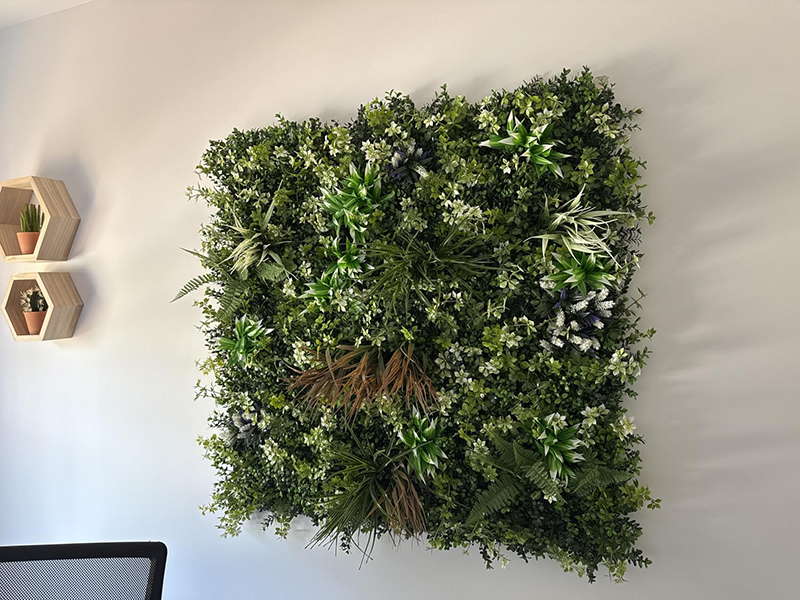Technical Specifications Development for 3D Artificial Vertical Gardens
The integration of 3D artificial vertical gardens into modern architecture requires precise technical specifications to ensure functionality, safety, and environmental compatibility. These guidelines, shaped by engineering principles, material science, and ecological considerations, provide a framework for designing systems that meet the demands of urban environments. From structural stability to long-term maintenance, technical specifications address every stage of a vertical garden’s lifecycle.

Structural Design and Load-Bearing Capacity
A foundational aspect of technical specifications for 3D artificial vertical gardens is structural design. Engineers must calculate the load-bearing capacity of the supporting framework, accounting for factors such as the weight of synthetic foliage, irrigation systems, and external forces like wind or seismic activity. For instance, specifications may require that the frame be constructed from corrosion-resistant materials, such as aluminum or stainless steel, to withstand environmental exposure without degrading.
The attachment mechanism to building facades or standalone structures is another critical consideration. Technical guidelines often mandate the use of non-invasive anchors or modular mounting systems that distribute weight evenly across the surface. In regions prone to high winds or earthquakes, specifications may include additional reinforcement requirements, such as diagonal bracing or vibration dampeners, to prevent system failure.
Load testing protocols are essential to validate structural integrity. Specifications may outline procedures for simulating extreme conditions, such as sustained gusts or heavy rainfall, to ensure the vertical garden remains securely fastened. These tests help identify potential weaknesses early in the design phase, reducing the risk of accidents post-installation.
Material Selection and Durability Standards
Material specifications play a pivotal role in determining the lifespan and performance of 3D artificial vertical gardens. Synthetic foliage must be engineered to resist fading, cracking, and discoloration caused by UV radiation. Guidelines often recommend the use of high-density polyethylene (HDPE) or polypropylene (PP) with UV stabilizers, which offer superior durability compared to standard plastics.
Fire safety is another priority, particularly for vertical gardens installed in commercial or high-rise buildings. Technical specifications may require that all materials meet fire-resistance ratings, such as Class A or B, as defined by international standards like ASTM E84 or EN 13501-1. Non-combustible coatings or flame-retardant treatments may also be specified to minimize fire spread in the event of an ignition source.
Environmental sustainability is increasingly influencing material choices. Specifications may encourage the use of recycled content in synthetic foliage or frames, reducing the carbon footprint of production. Additionally, guidelines might mandate that materials be recyclable or biodegradable at the end of their useful life, aligning with circular economy principles.
Irrigation and Water Management Systems
Efficient water use is a hallmark of well-designed 3D artificial vertical gardens, even though they rely on synthetic components. Technical specifications often include requirements for irrigation systems that minimize waste while maintaining plant aesthetics. Drip irrigation, for example, is a common recommendation due to its precision in delivering water directly to the base of foliage, reducing runoff and evaporation.
Water quality management is equally important. Specifications may require the integration of filtration systems to prevent clogging of irrigation nozzles from debris or mineral deposits. In areas with hard water, guidelines might suggest the use of water softeners or descaling agents to prolong the lifespan of the system.
Smart irrigation technologies are gaining traction in technical specifications. Sensors that monitor soil moisture (even in artificial systems to mimic natural conditions) or ambient humidity can trigger automated watering schedules, optimizing water use based on real-time data. These systems not only conserve resources but also reduce maintenance demands by preventing over- or under-watering.
Lighting and Energy Efficiency Requirements
For indoor or low-light applications, lighting specifications are critical to ensuring the visual appeal of 3D artificial vertical gardens. Guidelines may recommend LED fixtures due to their energy efficiency, long lifespan, and ability to produce a spectrum of light that enhances plant colors without appearing artificial.
Energy consumption targets are often included in technical documents to promote sustainability. Specifications might limit the wattage per square meter of vertical garden or require the use of motion sensors to activate lighting only when the area is occupied. In some cases, solar-powered lighting systems are encouraged for outdoor installations, reducing reliance on grid electricity.
Light pollution considerations are also addressed in specifications for urban environments. Guidelines may restrict the intensity or direction of lighting to avoid disrupting nocturnal ecosystems or neighboring residents. Shielding devices or downward-facing fixtures are common solutions to contain light within the vertical garden’s boundaries.
Maintenance and Long-Term Performance Protocols
To ensure 3D artificial vertical gardens remain functional and attractive over time, technical specifications must include detailed maintenance protocols. These guidelines outline the frequency of inspections for signs of wear, such as fading foliage or loose frame components, and procedures for replacing damaged parts.
Cleaning requirements are another key aspect. Specifications may recommend using mild, eco-friendly detergents to avoid damaging synthetic materials, along with soft-bristled brushes or low-pressure water sprays to remove dust or grime. For vertical gardens in high-traffic areas, more frequent cleaning schedules might be specified to maintain a pristine appearance.
Long-term performance metrics are often included to evaluate the system’s effectiveness. For example, specifications may define acceptable levels of color retention or structural stability after five or ten years of use, providing a benchmark for quality assurance. Manufacturers may be required to provide warranties or performance guarantees based on these metrics, incentivizing adherence to high standards.
Conclusion: The Importance of Rigor in Technical Specifications
Developing comprehensive technical specifications for 3D artificial vertical gardens is essential for their successful integration into urban landscapes. By addressing structural design, material selection, irrigation, lighting, and maintenance, these guidelines ensure that systems are safe, sustainable, and visually appealing. As technology advances and environmental concerns grow, ongoing refinement of technical specifications will be crucial in supporting the widespread adoption of vertical gardens as a cornerstone of green urban infrastructure.
Contact: Amy
Phone: 86-15311787313
E-mail: info@foszmac.com
Whatsapp:86-15311787313
Add: Fengtai District, Dacheng Road, No.24 Building, Room 203, Beijing, China